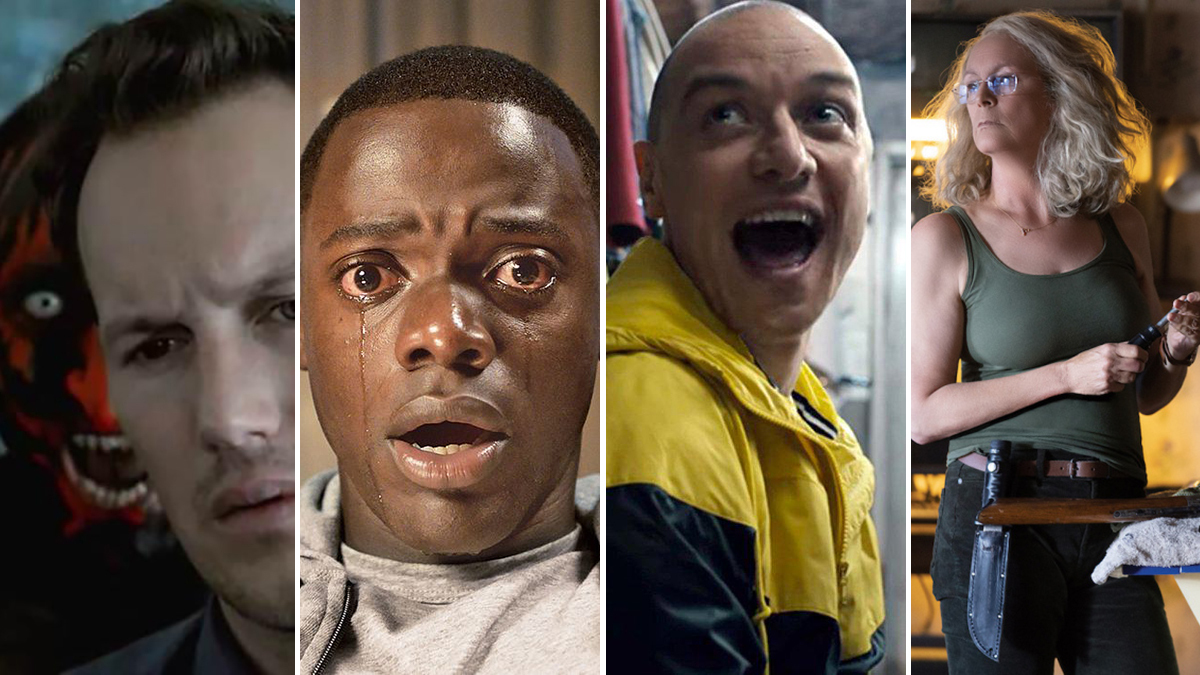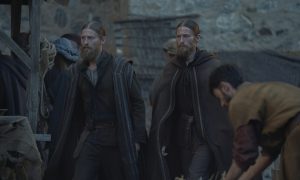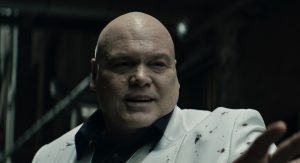
Has any single person had a greater impact on horror this century than Jason Blum? The one-time Miramax executive struck out on his own in the 2000s when he founded Blumhouse Productions, a company where he remains the CEO. And in the ensuing years, Blum’s production label would define, and redefine again, the trends of horror movies and thrillers.
Operating on the philosophy that a horror film with a micro-budget will almost always turn a profit, Blum frequently allows directors broad freedom to make what they want within the genre, and in the process has kept multiplexes perpetually spooky. In 2009, Blumhouse helped reinvent the found footage horror aesthetic, and in the 2010s, the modern phenomenon of talent-focused horror gems began with Blumhouse’s gambles.
Working with filmmakers like James Wan, Scott Derrickson, Ethan Hawke, and Jordan Peele, Blumhouse Productions’ title card is now a promise of something different, if still eminently commercial and entertaining. It even paved the way for the controversial modern discourse around “elevated” horror, with Peele’s Get Out being the first chiller to win an Oscar for screenwriting since The Silence of the Lambs.
Let’s take a look at the very best Blumhouse efforts that paid off with a bloody good time.
18. The Hunt
The Hunt, from director Craig Zobel and screenwriters Nick Cuse and Damon Lindelof, released to mixed reviews on March 13, 2020, just one week before the entire country shut down for the COVID pandemic. Unlucky as this timing might seem, it actually gave The Hunt surprising relevance. The Hunt stars Betty Gilpin as veteran Crystal May Creasey, who gets kidnapped with other working-class people of various political persuasions and hunted by rich elites.
The Hunt features plenty of political provocations and lots of blood and guts. But it primarily operates as an epistemological game, constantly undermining the audience’s knowledge. From an opening scene in which protagonists are introduced and then killed off to the final fight/intellectual debate, The Hunt violently illustrates the limits of our knowledge and the problem with adhering to ideology instead of fact. – Joe George
17. Hush
This taut thriller comes from Mike Flanagan, director of The Haunting of series and Doctor Sleep fame. Flanagan and his co-writer and star (and also wife), Kate Siegel, wanted to make a horror movie with little to no dialogue. So they came up with this concept of a deaf-mute woman (Siegel) in a remote house, who is stalked by a killer with a crossbow. Hush is at its peak in the first 20 minutes as the masked man (10 Cloverfield Lane’s John Gallagher Jr.) realizes his quarry can’t actually hear him and begins to play games.
The pair’s relationship with sound makes an interesting dynamic in this tense home invasion movie, though the cat and mouse chase does grow somewhat repetitive and generic as the film progresses. Still, a fine performance from Siegel and an indication of what Flanagan could do on a small budget make this very much worth checking out. – Rosie Fletcher
16. Happy Death Day
The Groundhog Day formula where an odious person is doomed to relive the same day countless times has proven remarkably flexible. And Happy Death Day is no exception with its horror-comedy blend of Punxsutawney hijinks and ‘80s slasher movie clichés. Starring a ridiculously game Jessica Rothe as Tree, the sorority girl who is constantly waking up with the hangover from hell, Happy Death Day follows the typical “Queen Bee” slasher archetype, and forces her to relive the same horror movie again and again. Until she can figure out who her masked killer is, and maybe how to be a better person, she’s condemned to die in increasingly preposterous ways. Worse still, she must also wake up in a dormitory afterward.
It’s derivative in a million different ways, but delightful in many more thanks to a cheeky atmosphere from director Christopher Landon and a very savvy, self-aware script by Scott Lobdell. Most of all though, it benefits from Rothe’s comedic talents on full display, as she backflips between initial verbal bitchiness and constant physical comedy. She even manages to find a little pathos, one stab wound at a time. – David Crow
15. The Visit
The Sixth Sense may remain M. Night Shyamalan’s masterpiece, but it was an oft-referenced moment from a different film that became key to Blumhouse pulling him back from the brink of irrelevance.
Having made four objectively terrible movies in a row, including the notoriously bad wind-smeller The Happening, Shyamalan seemingly decided to use what he’d learned from a very effective part of 2002’s Signs, where Joaquin Phoenix reacts to a tense home movie of an alien sighting, and took the next logical step: What if the director put together 90 minutes of unsettling home movie moments just like that?
Your mileage may vary with the handheld, mockumentary style of The Visit, but it’s hard to argue that this brisk, low-budget tale of two young siblings staying with some very, very odd grandparents they’ve never met before could play out more wildly than it does here. And Shyamalan certainly doesn’t pull many punches when it comes to putting those poor kids in peril during the film’s climax. – Kirsten Howard
14. Sweetheart
The idea of getting stranded on a desert island terrifies many people… especially filmmakers. How in the world do you tell a compelling story with one actor, by themselves? If you’re Sweetheart director J.D. Dillard, you keep things short and you hire an actor with oodles of charisma.
Sweetheart comes in just over 82 minutes and stars Kiersey Clemons as Jenn, a woman who survives a shipwreck only to find herself alone on an island. Well, almost alone, because each evening, a sea monster comes ashore.
What follows is pure cinema, as Jenn does battle with the monster, continues to deal with the bodies of her friends washing up on the beach, and making plans to get home. The plot gets a bit more complicated toward its third act, but Dillard and his co-writers Alex Hyner and Alex Theurer mostly keep things lean and exciting. – JG
13. Creep
No, not the one set on the subway. This Creep, directed by Patrick Brice, written by Brice and Mark Duplass, and also starring them both in a tense two-hander, is an altogether more unsettling affair. Brice plays Aaron, a videographer who answers an ad posted by Josef (Duplass), the latter saying he’s dying and wants a video diary made to leave to his son. But Josef’s behavior is weird—exactly how weird is too weird is the challenge faced by Aaron.
At just 77 mins long, this is a compact, unusual, often funny movie which picks at male relationships in the modern day, and how far kindness and politeness can override instinct. Duplass and Brice are incredibly natural in a film that’s extremely unusual, steeped in unease but not really like a traditional horror, with laughter and tension relief keeping you on your toes throughout. There’s a sequel which is good too, though if you can watch the first without spoilers it delivers a particular kind of dread that’s hard to replicate. – RF
12. Speak No Evil
Blumhouse is best known for going for the shocking and fun over the tone-y traumas of A24, so when fans of the dark, serious Danish movie Speak No Evil learned that an American remake was coming from Blumhouse, they feared the worst. However, fans of the original forget two details about the Danish film. First, that it is trash. How else could you explain a movie about psychos who befriend, psychologically abuse, and then mutilate vacationing families of three? Second, the original is thuddingly, belligerently dumb, the film equivalent of a college freshman who defends his flimsy thesis by shouting increasingly irrelevant evidence.
When Blumhouse got trashmeister James Watkins to write and direct and cast the gleeful James McAvoy in the lead, the American Speak No Evil lost its tone of dread but became a good movie. Watkins managed to somehow sell the logic leaps that required American travelers (Mackenzie Davis and Scoot McNairy) to stay with their overbearing hosts (McAvoy and Aisling Franciosi). Even better, Watkins and his team found notes of pathos missing from the original, resulting in a film both sillier and richer than its predecessor. – JG
11. M3GAN
Forget Stranger Things or Wednesday, two limp Netflix series that try to introduce younger viewers to chills and thrills. The definitive Zoomer horror flick is M3GAN with its TikTok-ready marketing and its ambivalent take on technology. Stories about killer dolls are certainly nothing new, as Chucky or The Twilight Zone’s Talking Tina can attest. But M3GAN gives the trope a decidedly 21st century spin, making the Model 3 Generative ANdroid neither a product of dark magic or a vengeful spirit, but of the ever-present internet and its corporate colonizers.
The script by Akela Cooper, based on a story she developed with James Wan, M3GAN leans into the absurdity of toys designed to sell friendship to kids. “I had a dog, she was my only friend / but she got old and died and I’m alone again,” declares the jingle that opens the movie, a commercial for Perpetual Pets that hock hideous-looking furry toys to parents desperate to protect their children from even the slightest pang of loss. And yet, Cooper and director Gerard Johnstone find notes of genuine pathos within the absurdity, getting a moving performance from child actor Violet McGraw as an orphaned girl living with her kid-ambivalent aunt (Allison Williams).
Not that any tween checking out M3GAN cares about that nonsense. They’re here to see M3GAN do a cool dance before offing a victim, or to hear social media star Jenna Davis deliver solid voice acting as M3GAN (young New Zealander Amie Donald performed M3GAN’s body). Smart, funny, and scary, M3GAN assures even old farts like me that the next generation of horror hounds have a bright (dark?) future ahead of them. – JG
10. The Black Phone
Writer Joe Hill can go by whatever name he likes, but he’s always going to be Stephen King’s son. Even if Hill’s short story “The Black Phone” doesn’t borrow from too many of dad’s tropes, director Scott Derrickson, working with frequent co-writer C. Robert Cargill, adds a heavy dose of King nostalgia to his adaptation.
This is not a bad thing. Set in the 1970s, The Black Phone blends nostalgia for better days with a clear-eyed look at the danger facing latchkey kids. A masked and magnetic Ethan Hawke plays the Grabber, a man who kidnaps young boys and locks them in his basement for a series of brutal, inexplicable games.
The movie focuses on the Grabber’s latest victim Finney (Mason Thames) and his foul-mouthed and psychic little sister Gwen (Madeleine McGraw). Locked in the Grabber’s basement, Finney’s sole hope comes via a disconnected black phone, through which he talks with the Grabber’s other victims.
Derrickson fills the movie with excellent scare sequences, all enhanced by outstanding performances, especially by Thames and McGraw. Even better, Derrickson brings real pathos to scenes involving the kids’ home life with their troubled and abusive father (Jeremy Davies). These qualities allow Derrickson and Cargill to make The Black Phone more than a King-infused Hill adaptation and into something personal and special. – JG
9. Halloween
In resurrecting one of horror’s most enduring—yet stubbornly uneven—franchises, director David Gordon Green (working with screenwriters Danny McBride and Jeff Fradley) made the smartest move he could: He stripped away the ridiculously convoluted and nonsensical mythology the franchise had built up over decades. Instead, he simply made a direct sequel to Carpenter’s 1978 masterpiece.
The result was easily the best Halloween movie since the original itself, bringing the characters and the story into the present while reverting Michael Myers back to the enigmatic, unstoppable, unknowable force that was so terrifying in the first film. Jamie Lee Curtis, Judy Greer, and Andi Matichak as three generations of Strode women bring healthy feminine empowerment to the proceedings while the intense violence and uneasy psychological underpinnings give this Halloween a resonance that has been lacking for so long. – Don Kaye
8. Split
As the movie that suggested M. Night Shyamalan’s renaissance was real, Split is still a surprising box office win for the eclectic filmmaker. With a grizzly premise about a man suffering from Dissociative Identity Disorder (formerly known as split personality) kidnapping teen girls to hold in a zoo, this could be the stuff of ‘70s grindhouse sleaze. While there is a touch of that to Split, more critically the movie acts as a buoyant showcase for James McAvoy at his most unbound.
Playing a character with 24 different personalities, a shaved and beefy McAvoy is visibly giddy bouncing between multiple alters that include a deceptively sweet little boy, an OCD fashion designer, and a bestial final form. The commitment he shows to each also becomes its own special effect, causing you to swear his physical shape is changing with his expressions.
Similarly, scenes with theater legend Betty Buckley as his psychiatrist also rivet with the energy of a stage play, and suggest a sincere sympathy for mental illness. A rarity in horror. Nevertheless, the movie still comes down to his alters’ obsessions with their kidnapped prize (Anya Taylor-Joy), a young woman who hides demons of her own. When these true selves finally cross paths in a genuinely tense finale, Split is maniacally thrilling. – DC
7. Sinister
An unsettling entry in the horror subgenre of writers who destroy their families, Sinister marked director/co-writer Scott Derrickson’s return to horror after he detoured with an ill-fated remake of The Day the Earth Stood Still. Thus Derrickson and co-writer C. Robert Cargill concocted a unique, if somewhat scattershot, mythology about a pagan deity that murders entire families in the ghastliest ways imaginable.
True crime writer Ethan Hawke discovers the extent of those murders in a box of 8mm films left in the attic of his new home (where the last killings took place), and it’s the unspooling of those films—along with long sequences of Hawke moving through the shadows and silence of the house—that provide Sinister with its sickening core and palpable dread. Derrickson sustains the film’s foreboding mood for the entire running time, making the movie an authentically frightening experience. – DK
6. Oculus
The film that brought much of the world’s attention to Mike Flanagan, Oculus turned out to be a preview for the horror filmmaker’s interests. It also remains a truly unnerving ghost story. Not since the days of Dead of Night has a film so successfully made you scared of looking in a mirror.
Officially titled the Lasser Glass, the mirror in question is the apparent supernatural cause of hundreds of deaths, including the parents of Kaylie Russell (Karen Gillan) and her brother Tim (Brenton Thwaites). When they were children, their mother starved and mutilated herself before their father killed her. But now as an adult, Kaylie is convinced she can prove the antique glass is the true culprit, and she’ll document its evil power before destroying it. But the funny thing about evil mirrors is they have ways of protecting themselves, and wreaking havoc on a sense of time, place, and certainly self-image.
With the movie’s near masterful blending of events occurring 11 years ago and in the present, Flanagan revealed a knack for dreamlike structure, and stories about the past damning the future. These are ideas he’s gone on to explore in richer detail with The Haunting of Hill House and Doctor Sleep, but Flanagan’s ability to juxtapose childhood trauma with a nightmarish present was never more potent, or tragic, than in Oculus’ refracted gaze. – DC
5. The First Purge
The Purge franchise might constitute the strangest set of movies in the Blumhouse stable. They all stem from a premise inspired in part by the classic Star Trek episode “The Return of the Archons,” in which the United States recovers from economic disaster by suspending the law for an annual 12-hour period. The premise did enough to carry the first entry, a solid if unexceptional home invasion flick starring Ethan Hawke and Lena Heady. But as the franchise expanded, it needed to do more explaining about why making crime legal would help the country as a whole.
Turns out, it doesn’t. Writer and director James DeMonaco used the two immediate follow-ups The Purge: Anarchy and The Purge: Election Year to tie the Purge to a right wing conspiracy, which became explicit in 2018’s The First Purge. Written by DeMonaco and directed by Gerard McMurray, The First Purge does standard prequel business, showing the origins of conservative political group New Founding Fathers of America (NFFA) and how they tested their ideas in a largely non-white, economically depressed section of Staten Island.
However, McMurray and DeMonaco transcend standard prequel business by tapping into the fears and angers of America under the Trump Administration. The First Purge makes clear that all of the NFFA’s talk of economic science and moral turpitude is nothing more than racism and class hatred. McMurray frames scenes of genuine terror when Nazis and Klansmen enter non-white areas and kill with impunity. But he also reverses it into cathartic heroism when drug dealer Dmitri (Y’lan Noel) leads the community in a revolt against the White Supremacists. – JG
4. Paranormal Activity
It may take some mental gymnastics, but if you can take a step back and ignore all the sequels that followed in the wake of this surprise 2009 blockbuster, then you’d remember Paranormal Activity is a stone cold classic. It is also the movie that put Blumhouse on the map. Already mostly finished when Jason Blum saw a DVD screener of Oren Peli’s Paranormal Activity, this $15,000-budgeted terror is arguably the most evocative use of found footage in all of horror.
While Peli is obviously influenced by 1999’s The Blair Witch Project, that earlier movie is as famous for its shaky disorientation as it is its scares. By contrast what occurs in Paranormal Activity is excruciatingly clear. Seriously, the camera barely moves! Instead, we’re asked to sit back and watch in near slow motion as an unwise couple (Katie Featherston and Micah Sloat) meddle with forces that were better off left undisturbed.
It begins when Micah brings a home video camera into their house to track apparent ghosts in the dark; it ends in a demonic rush of violence. Everything in between is tracked by a disinterested lens, which usually sits statically in a corner or on a tripod, capturing the tedium of everyday life in its everyday natural lighting. Only occasionally does the horned shadow on the wall manifest. But then Paranormal Activity is chilling in its isolation. – DC
3. Insidious
As the fourth feature film directed by Australian filmmaker James Wan, Insidious follows a couple named Josh and Renai Lambert (Patrick Wilson and Rose Byrne), whose son inexplicably falls into a coma and becomes a vessel for malevolent entities from a dimension called the Further. The family enlists a psychic named Elise Rainier (Lin Shaye) in a battle involving astral projection and demonic possession.
Following an era of horror films that were more torture porn or police procedural (including Wan’s own Saw), Insidious was a return to the kind of horror filmmaking that was dependent on atmosphere, suspense, and what you don’t see lurking in the shadows. And Wan seemed to imbue that creepiness around the edges of every shot. Using actual adult characters and developing them (as opposed to the hipster teens that infested nearly every horror movie for at least 10 years previously) also set the film apart as a serious attempt at a genre that had been too often exploited in a tossed-off fashion.
The world-building of Insidious left the door open for sequels, of course, and while the three produced so far have had their moments, none has matched the sheer invention and terrifying fun of the original. – DK
2. The Invisible Man
Leigh Whannell’s reimagining of the classic Universal Monster, the Invisible Man, was as much of a surprise when it hit screens in 2020 as the titular villain himself. As a smart social commentary on domestic abuse and gaslighting, while also being enormously effective as a straight up horror, this was a highly fresh take on an old standard.
At the core was the terrific performance of Elisabeth Moss as Cecilia, a woman stuck with her controlling boyfriend Adrian (Oliver Jackson-Cohen) in their high-tech, high security fortress of a home. When Cece finally manages to escape and Adrian appears to take his own life, she hopes her ordeal can finally be over. But in fact it’s just beginning.
Playing on the true horror of not being believed, Whannell’s Invisible Man is as harrowing at times as it is thrilling. Yes, there are some extraordinarily shocking set pieces—the restaurant scene of course stands out—but it’s the increasing desperation of Cece, whose world is falling apart at the manipulative hands of a man who won’t let her go, which stays with you.
The Invisible Man is a thrilling horror, for sure, with a feel good ending (if you want to read it that way…), but it’s something altogether more exciting than that too: a fresh, relevant take on a classic, expertly directed and boasting star power delivered on a moderate budget, which flexes exactly what horror can do. – RF
1. Get Out
More impressive than any awards it won, Jordan Peele’s Get Out encapsulates the essential draw of horror: through entertaining “scares,” it unmasks truths folks might find too horrifying or uncomfortable to acknowledge. In the case of Get Out, it is the despair of Blackness and Black bodies still being commodified by a predatory American culture.
Wearing influences like Rosemary’s Baby and Stepford Wives on his sleeve, Peele pulls from classic horror conventions for his directorial debut, but gives them a startling 21st century sheen. His movie’s insidious conspiracy is neither an obvious coven of witches or the openly racist heavies of a period piece. Rather Peele sets his story about a Black man (Daniel Kaluuya) coming to meet his white girlfriend’s parents in a liberal conclave of wealthy suburbia. Written during the final days of the Obama years, Peele casts these parents (Bradley Whitford and Catherine Keener) as genial and welcoming, shielding cries of racism behind fashionable political correctness.
Yet once Peele moves past that trendy veneer, he finds a potent allegory in which the ghosts of slavery are still alive and well, even in Upstate New York. Peele also packs anxieties about interracial relationships, culture clash, and childhood trauma into a film that is nevertheless gregariously funny. Ultimately though, its final effect is triggering in the best way. Get Out offers an opportunity to confront real dread, one uneasy laugh, and then sudden jump scare, at a time. – DC
The post The Best Blumhouse Horror Movies of All Time, Ranked appeared first on Den of Geek.





